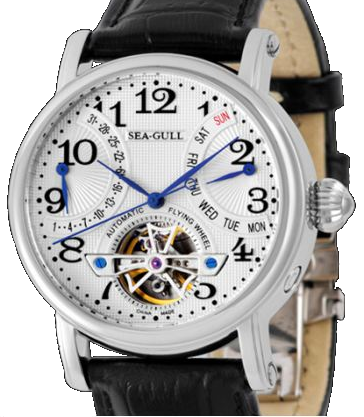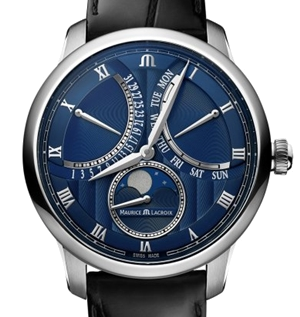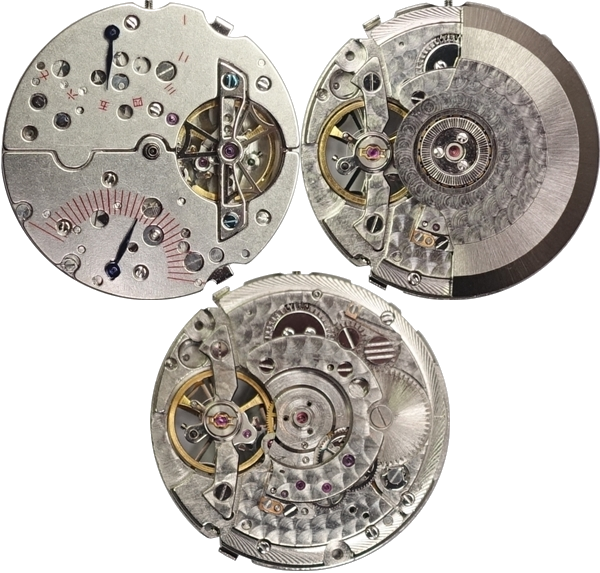A retrograde, i.e. reversing, display on a watch is a complication in which a hand, for example for the time or date, moves over a segment of a circle. Instead of turning completely in a circle, the hand jumps back to the starting position in a sudden manner as soon as it reaches the end of the segment scale.

Do you need it and is it useful? Not necessarily! Why do you do it then? Because it is possible!
And sometimes it’s also quite nice to look at. Which only applies to a very limited extent to the watch shown above, whose movement we’ll take a closer look at in a moment. Of course, there are much higher-quality watches with retrograde displays, such as the Maurice Lacroix Masterpiece Moonphase Retrograde.

The retrograde display should not be confused with a retrograde watch. In this case, the time display runs backwards, i.e. counterclockwise. These are often fun watches, but it also makes sense with Hebrew-labeled watches because of the different reading direction of Hebrew.
And of course, there are other displays whose hands only sweep a segment of a circle, but which are not retrograde because they don’t jump back to the starting position. The power reserve indicator is an example of this. It moves slowly in one direction when the movement is wound, and slowly back again when it is running down.
In most retrograde displays, this is not the focus, but merely complements a classic time display. This is not the case with the Sector Watch from the Swiss manufacturer Record Watch, which was built from 1903 to 1908. It displays both the hours and the minutes retrograde. Today a much sought-after piece of watch history among collectors!

Now, this is about the movement of the watch shown above, a Seagull ST2504, also called TY2504. Fun fact on the side: the company is called Sea-Gull with a hyphen, but the movements are named Seagull.

The mechanism for the two retrograde displays is located on the dial side under two separate cover plates. The retrograde day display is shown at the top of the picture, the date at the bottom.

First, let’s take a closer look at the retrograde display of the day:

The plastic part marked with 1 ensures that wheel 2 is advanced by one tooth every 24 hours, analogous to a date driving wheel in the classic date mechanism. Permanently connected to 2 is the cam disk 3. Actually, there are two cam disks, one for each of seven days. Wheel 2 has 14 teeth, not only seven. It therefore needs two weeks for a full revolution.
Each time part 1 advances wheel 2, cam 3 rotates a little further to the right. This causes the tip of part 4 to slide up a little further. The teeth on the upper edge of 4 thus turn the small wheel 5 a little further to the right. In the center of this wheel is the hand for the day of the week, which moves up a little on the dial.
On Sunday, part 4 is at the highest point of the cam, so wheel 5 has moved the maximum possible distance to the right. Accordingly, the hand on the dial has also reached its highest point. When switching to Monday, part 4 drops down abruptly at the edge of the cam plate, since a small spring presses part 4 down. The teeth on 4 then simultaneously turn wheel 5 back to the left, and the hand for the day of the week thus jumps back to Monday.
The click 6 in the picture above only holds the wheel 2 in the respective position. And 7 is used for quick adjustment of the day via a pusher at 4 o’clock on the watch case.
The retrograde display for the date works on the same principle:

Here, wheel 2 does not have 14 teeth, but 31. Accordingly, 3 consists of only one cam. The wheel 5 also carries the hand here, but it also has very fine external teeth in which the click 6a engages. It only serves to stabilize the position of the date hand. A pusher at 8 o’clock on the watch case serves to quickly adjust the date via part 7.
That’s it for the retrograde display of this movement. Actually, the construction is technically quite simple.
